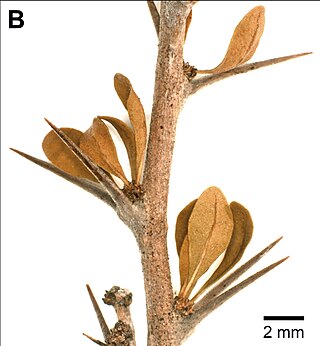
Plumeria, also known as frangipani, is a genus of flowering plants in the subfamily Rauvolfioideae, of the family Apocynaceae. Most species are deciduous shrubs or small trees. The species are native to the Neotropical realm, but are often grown as cosmopolitan ornamentals in tropical regions, especially in Hawaii, as well as hot desert climates in the Arabian Peninsula with proper irrigation.

Leucocroton is a plant genus of the family Euphorbiaceae first described as a genus in 1861. The entire genus is endemic to Cuba. It is a member of the Leucocroton alliance, which also includes Garciadelia and Lasiocroton. Species in this alliance are dioecious.
Bernardia is a plant genus of the family Euphorbiaceae first described for modern science as a genus in 1754. It is native to North and South America, as well as the West Indies.

Chaetocarpus is a plant genus of the family Peraceae, formerly Euphorbiaceae, first described as a genus in 1854. Chaetocarpus species are trees or shrubs. They are native to the Americas, Africa, and Asia. Some species are endangered.
- Chaetocarpus acutifolius(Britton & P.Wilson) Borhidi – Sierra de Moa in Cuba
- Chaetocarpus africanusPax – C Africa
- Chaetocarpus castanocarpus(Roxb.) Thwaites – SE Asia, Yunnan, Assam, Bangladesh, Sri Lanka
- Chaetocarpus cordifolius(Urb.) Borhidi – Cuba, Hispaniola, Jamaica
- Chaetocarpus coriaceusThwaites – Sri Lanka
- Chaetocarpus cubensisFawc. & Rendle – Cuba
- Chaetocarpus echinocarpus (Baill.) Ducke – Bolivia, Brazil
- Chaetocarpus ferrugineusPhilcox – Sri Lanka
- Chaetocarpus gabonensisBreteler – Gabon
- Chaetocarpus globosus(Sw.) Fawc. & Rendle – Jamaica, Cuba, Dominican Rep.
- Chaetocarpus myrsinitesBaill. – Bolivia, Brazil
- Chaetocarpus parvifoliusBorhidi – Cuba
- Chaetocarpus pearceiRusby – Bolivia
- Chaetocarpus pubescens(Thwaites) Hook.f. – Sri Lanka
- Chaetocarpus rabarabaCapuron – Madagascar
- Chaetocarpus schomburgkianus(Kuntze) Pax & K.Hoffm. – Colombia, Venezuela, 3 Guianas, NW Brazil

Argythamnia is a genus of plants of the family Euphorbiaceae first described as a genus in 1756. They are known commonly as silverbushes.

Acidoton is a genus of plant of the family Euphorbiaceae first described as a genus in 1788. It is native to the Greater Antilles, Central America, and tropical South America.
Ditta is a genus of plants, under the family Euphorbiaceae first described as a genus in 1861. It is native to the Greater Antilles in the Caribbean.
- Ditta maestrensisBorhidi - Sierra Maestra in SE Cuba
- Ditta myricoidesGriseb. - Cuba, Hispaniola, Puerto Rico

Acidocroton is a genus of plants under the family Euphorbiaceae first described with this name in 1859. It is native to Colombia and the Greater Antilles.
Bonania is a plant genus of the family Euphorbiaceae first described as a genus in 1850. It is native to the West Indies.
- Bonania cubanaA.Rich. - Bahamas, Cuba
- Bonania domingensis(Urb.) Urb. - Haiti, Dominican Rep
- Bonania ellipticaUrb. - Cuba
- Bonania emarginataC.Wright ex Griseb. - Cuba
- Bonania erythrosperma(Griseb.) Benth. & Hook.f. ex B.D.Jacks. - Cuba
- Bonania linearifoliaUrb. & Ekman - Haiti
- †Bonania myricifolia(Griseb.) Benth. & Hook.f. - Guantánamo but extinct
Grimmeodendron is a plant genus of the family Euphorbiaceae first described as a genus in 1908. It is native to the West Indies.
- Grimmeodendron eglandulosum(A.Rich.) Urb. - Bahamas, Cuba, Hispaniola
- Grimmeodendron jamaicenseUrb. - Jamaica
Chascotheca is a genus of plants in the family Phyllanthaceae described as a genus in 1904. It is native to the western Caribbean.
- Chascotheca neopeltandra(Griseb.) Urb. - Cuba, Hispaniola, Cayman Islands
- Chascotheca triplinervia(Müll.Arg.) G.L.Webster - Cuba

Pimenta is a genus of flowering plants in the myrtle family, Myrtaceae described as a genus in 1821. It is native to Central and South America, Mexico, and the West Indies.

Cameraria is a genus of plants in family Apocynaceae, first described for modern science by Linnaeus in 1753. It is native to southern Mexico, Central America, and the West Indies.
Bernardia trelawniensis is a species of flowering plant in the euphorb family, Euphorbiaceae. It is endemic to the Cockpit Country of Jamaica. The authors of a 2008 publication reclassified the species as Critically Endangered according to the IUCN guidelines.
Strempeliopsis is a genus of plant in family Apocynaceae, first described as a genus in 1876. The entire genus is known only from the West Indies, islands of Cuba and Jamaica.
- Strempeliopsis arboreaUrb. - W Jamaica
- Strempeliopsis strempelioides(Griseb.) Benth. ex B.D.Jacks. - Cuba

Wallenia is a genus of flowering plants in the family Primulaceae endemic to the West Indies. It is composed of 29 species. It also includes a subgenus, Homowallenia, with ten species from the northern Caribbean.

Rondeletia is a genus of flowering plants in the family Rubiaceae. It is endemic to the Neotropics. There are around 160 species.

Catesbaea is a genus of flowering plants in the family Rubiaceae. It occurs in the West Indies, The Bahamas, and the Florida Keys. The genus is named in honour of English naturalist Mark Catesby.
Pseudocarpidium is a genus of flowering plants in the family Lamiaceae first described in 1906. It is native the West Indies.
- Pseudocarpidium avicennioides(A.Rich.) Millsp. - eastern Cuba
- Pseudocarpidium domingense(Urb. & Ekman) Moldenke - Hispaniola
- Pseudocarpidium ilicifolium (A.Rich.) Millsp. - Cuba
- Pseudocarpidium multidens(Urb.) Moldenke - eastern Cuba
- Pseudocarpidium neglectaBisse - Cuba
- Pseudocarpidium pungensBritton - eastern Cuba
- Pseudocarpidium rigens(Griseb.) Britton - eastern Cuba
- Pseudocarpidium shaferiBritton - eastern Cuba
- Pseudocarpidium wrightiiMillsp. - Bahamas, Cuba
Garciadelia is a plant genus of the family Euphorbiaceae first described as a genus in 2010. The entire genus is endemic to the Island of Hispaniola in the West Indies (divided between Haiti and the Dominican Republic. It is a member of the Leucocroton alliance, which also includes Leucocroton and Lasiocroton. Species in this alliance are dioecious.
- Garciadelia abbottiiJestrow & Jiménez Rodr. - Dominican Republic
- Garciadelia castilloaeJestrow & Jiménez Rodr. - Dominican Republic
- Garciadelia leprosa Jestrow & Jiménez Rodr. - Haiti, Dominican Republic
- Garciadelia mejiaeJestrow & Jiménez Rodr. - Dominican Republic










